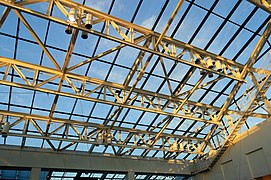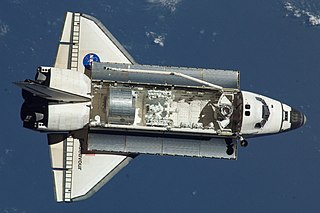
Space Shuttle Endeavour is a retired orbiter from NASA's Space Shuttle program and the fifth and final operational Shuttle built. It embarked on its first mission, STS-49, in May 1992 and its 25th and final mission, STS-134, in May 2011. STS-134 was expected to be the final mission of the Space Shuttle program, but with the authorization of STS-135 by the United States Congress, Atlantis became the last shuttle to fly.

The Space Shuttle program was the fourth human spaceflight program carried out by the U.S. National Aeronautics and Space Administration (NASA), which accomplished routine transportation for Earth-to-orbit crew and cargo from 1981 to 2011. Its official name, Space Transportation System (STS), was taken from a 1969 plan for a system of reusable spacecraft of which it was the only item funded for development. It flew 135 missions and carried 355 astronauts from 16 countries, many on multiple trips.
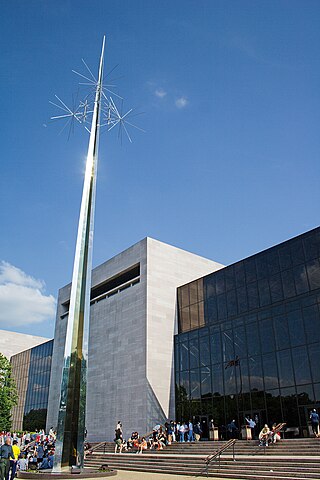
The National Air and Space Museum (NASM) of the Smithsonian Institution, is a museum in Washington, D.C., in the United States dedicated to human flight and space exploration.
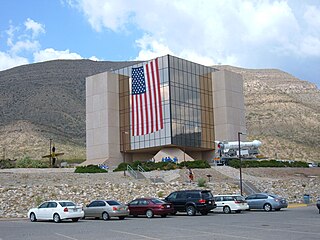
The New Mexico Museum of Space History is a museum and planetarium complex in Alamogordo, New Mexico, United States, dedicated to artifacts and displays related to space flight and the Space Age. It includes the International Space Hall of Fame. The Museum of Space History highlights the role that New Mexico has had in the U. S. space program, and is one of eight museums administered by the New Mexico Department of Cultural Affairs. The museum has been accredited by American Alliance of Museums since 1993. The museum is also a Smithsonian Affiliate.

The Los Angeles County Museum of Art (LACMA) is an art museum located on Wilshire Boulevard in the Miracle Mile vicinity of Los Angeles. LACMA is on Museum Row, adjacent to the La Brea Tar Pits.

The Museum of Flight is a private non-profit air and space museum in the Seattle metropolitan area. It is located at the southern end of King County International Airport in the city of Tukwila, immediately south of Seattle. It was established in 1965 and is fully accredited by the American Alliance of Museums. As the largest private air and space museum in the world, it also hosts large K–12 educational programs.

The Shuttle Carrier Aircraft (SCA) are two retired extensively modified Boeing 747 airliners that NASA used to transport Space Shuttle orbiters. One (N905NA) is a 747-100 model, while the other (N911NA) is a short-range 747-100SR.

Cosmosphere is a space museum and STEM education center in Hutchinson, Kansas, United States. It was previously known as the Kansas Cosmosphere. The museum houses over 13,000 spaceflight artifacts—the largest combined collection of US and Russian spaceflight artifacts in the world, and is home to various space educational programs.

The National Museum of the United States Air Force is the official museum of the United States Air Force located at Wright-Patterson Air Force Base, six miles (9.7 km) northeast of Dayton, Ohio. The NMUSAF is the oldest and largest military aviation museum in the world, with more than 360 aircraft and missiles on display. The museum draws about a million visitors each year, making it one of the most frequently visited tourist attractions in Ohio.

Exposition Park is a 160-acre urban park (65 ha) in the south region of Los Angeles, California, in the Exposition Park neighborhood. Established in 1872 as an agricultural fairground, the park includes the Los Angeles Memorial Coliseum, BMO Stadium, the California Science Center, the Natural History Museum of Los Angeles County, and the California African American Museum. The Lucas Museum of Narrative Art is under construction. Bounded by Exposition Boulevard to the north, South Figueroa Street to the east, Martin Luther King Jr. Boulevard to the south and Vermont Avenue to the west, it is directly south of the main campus of the University of Southern California.
The International Space Development Conference (ISDC) is the annual conference of the National Space Society (NSS). Now in its 41st year, these conferences connect the general public and the NSS membership with leaders of contemporary space efforts. The ISDC provides a nexus for industry, government, scientists, advocates, and the public to meet and discuss the latest issues in space technology, science, policy, commerce, medicine, exploration, settlement and much more. Winners of the annual NASA space settlement Contest annually attend the conference, with several interesting activities and programs. With National Space Society's major goal being to accelerate the process of space exploration and development they also foster astronautics for students by encouraging them and getting them involved.

San Diego Air & Space Museum is an aviation and space exploration museum in San Diego, California, United States. The museum is located in Balboa Park and is housed in the former Ford Building, which is listed on the US National Register of Historic Places. SDASM was established by articles of incorporation on October 12, 1961, and opened to the public on February 15, 1963.
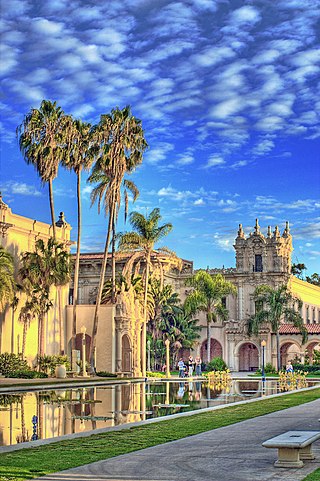
The California Pacific International Exposition was an exposition held in San Diego, California during May 29, 1935–November 11, 1935 and February 12, 1936–September 9, 1936. The exposition was held in Balboa Park, San Diego's large central urban park, which had also been the site of the earlier Panama-California Exposition in 1915.
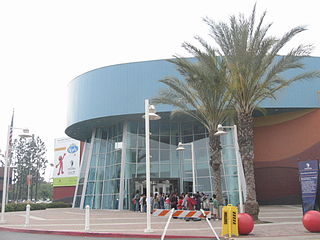
The Discovery Cube Orange County, formerly known as the Discovery Science Center and the Taco Bell Discovery Science Center, is a science museum in Santa Ana, California, with more than 100 hands-on science exhibits designed to spark children's natural curiosity. Designed by the architect firm Arquitectonica with structural engineers Carl Johnson and Svend Nielsen, it has become a visual landmark due to its ten-story solar array cube that stands over Interstate 5.

The Space Shuttle orbiter is the spaceplane component of the Space Shuttle, a partially reusable orbital spacecraft system that was part of the discontinued Space Shuttle program. Operated from 1981 to 2011 by NASA, the U.S. space agency, this vehicle could carry astronauts and payloads into low Earth orbit, perform in-space operations, then re-enter the atmosphere and land as a glider, returning its crew and any on-board payload to the Earth.

The Ford Building, a Streamline Moderne structure in Balboa Park, San Diego, California, serves as the home of the San Diego Air & Space Museum. The building was built by the Ford Motor Company for the California Pacific International Exposition, which was held in 1935 and 1936. The Ford Motor Company built a total of five exposition buildings for the world's fairs. This is the last remaining structure.
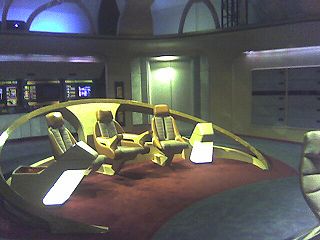
Star Trek: The Exhibition is a traveling museum display of Star Trek items and memorabilia. The exhibit includes items used in the films and television series, such as props, costumes, set components and full-scale replicas of the Enterprise bridge. Other comprehensive features of the exhibit include a complete timeline showing major events in the Star Trek Universe and how all of the various series and movies relate to each other chronologically, as well as a motion simulator ride.

The Virginia Air and Space Science Center is a museum and educational facility in Hampton, Virginia that also serves as the visitors center for NASA's Langley Research Center and Langley Air Force Base. The museum also features an IMAX digital theater and offers summer aeronautic- and space-themed camps for children.
Samuel Oschin, born in Dayton, Ohio, was a Los Angeles entrepreneur and philanthropist.
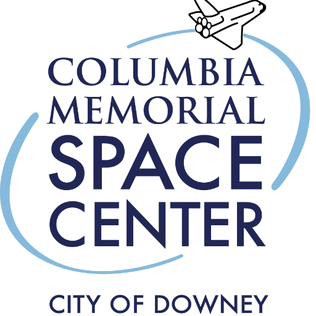
The Columbia Memorial Space Center (CMSC) is a science museum in the Los Angeles area, at 12400 Columbia Way, City of Downey, California, US. It is owned and operated by Downey, and open to the general public as a hands-on space museum and activity center.












